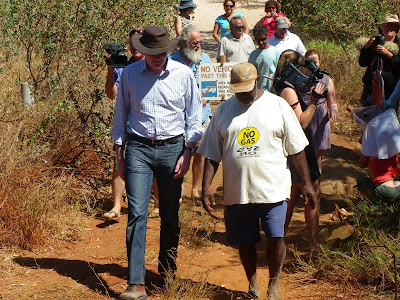MEDIA RELEASE
Statement from Goolarabooloo Law Boss Joseph Roe. Monday 15 August 2011
Goolarabooloo insist Woodside cease landclearing and drilling immediately.
Following last week’s discovery of adult Greater Bilbies at the proposed James Price Point gas hub site, research cameras have this week revealed a further three baby bilbies at the same location.
These recent sightings of Greater Bilbies, including juveniles, are in the exact location that Woodside is currently undertaking landclearing at the proposed gas hub site.
This landclearing is taking place prior to federal environmental approval for the project.
“These pictures confirm what we as Goolarbooloo already knew: bilbies are here on this country. It’s also what the Government’s own reports have told them, if only they’d listen,” Goolarabooloo Law Boss Joseph Roe said in Broome today.
In 2008, the State Government’s own reports identified a number of protected mammal species, including the Greater Bilby, likely to be found on the Dampier Peninsula (see attached fact sheet for details).
This species faces a very high risk of extinction in the wild and is protected under both state and federal environmental laws, and listed globally on the World Conservation Union’s ‘red list’ of endangered species.
In 2009, subsequent environmental surveys commissioned by the State Government found ‘evidence of presence’ of Greater Bilbies in the proposed precinct area.
Woodside and the State Government chose to ignore all these reports, and have taken no further action to ensure this protected species is indeed protected within their proposal to build a gas hub at James Price Point.
“We hear Woodside and the Government talking up this proposal as ‘world’s best practice’ – but any sensible person can see that this company and the government are determined to look the other way when it comes to protecting the environment here.”
“Amateur naturalists with a motion-sensor camera found direct evidence of this species in one month that Woodside haven’t found in four years. It’s time they worked a lot harder to meet their environmental obligations.”
“Goolarabooloo insist that the State and Federal governments step in to immediately stop Woodside landclearing while they work out how to protect this species as their state and federal laws say they must,” Joseph Roe concluded.
The last time a live bilby was positively identified on the Dampier Peninsula was in 1991.
Looking the other way:
A three year timeline of fauna reports, surveys and commentary by the State government and Woodside re the Greater Bilby and other protected species
When the State government first looked at four possible sites for the proposed oil and gas refinery in the Kimberley, they commissioned a number of reports to determine the possible presence of protected species.
Three reports document fauna of the James Price Point area, using a variety of methods to assess whether a particular species is present or not. Evidence of a species is determined by either:
1. Direct evidence i.e. a confirmed sighting of an animal; or
2. Evidence of presence i.e. indicators of presence such as burrows, tracks and animal scats.
2008
A broad survey of four possible Kimberley sites for the proposed oil and gas refinery is undertaken over nine days as part of a preliminary report. This report makes particular note of the Greater Bilby:
“…No systematic survey for bilby burrows was possible in the survey area…so it is unknown to what extent
bilbies are present…”
“…It is likely that this species [the Greater Bilby] occupies most of the Peninsula in very low densities. As it is
a conservation-significant species under significant pressure from fire and predation, systematic bilby
searches are recommended once the proposed development site is selected, if it contains or is close
to suitable Bilby habitat…” [our emphasis added]
2009
James Price Point is selected as the preferred site for Woodside’s proposed oil and gas refineries. A Wet Season fauna survey (5- 31 March 2009) identifies 37 species of ‘elevated conservation significance’, occurring or potentially occurring in the James Price Point area, including the Greater Bilby.
Though not definitively sighted through direct evidence, the Greater Bilby is considered to be potentially occurring in the area .
The report also notes “…further effort would be likely to yield additional species”
2010
A supplementary State Government-commissioned fauna and habitat assessment is released in 2010, based on a five day Dry Season survey undertaken in November 2009.
This survey finds ‘evidence of presence’ of the Greater Bilby in the form of burrows and tracks .
No further work has since been undertaken to determine direct evidence of this species at the proposed site.
2011
As part of its PR material to defend commencing landclearing at James Price Point, Woodside issue an ‘Activity Update’ in June 2011. Under the ‘Environment Management Plans’ heading, this fact sheet states:
“…Woodside has conducted extensive environmental studies of this area as part of planning for this activity. The land clearing will not significantly impact on any matters of National Significance. No EPBC Act-listed threatened species have been directly recorded in the James Price Point coastal area. In addition, Woodside has prepared detailed environmental and heritage management plans to support the activity…” [our emphasis added]
OTHER PROTECTED SPECIES FOUND IN THE VICINITY OF JAMES PRICE POINT.
In addition to Greater Bilbies, the 2009 Wet Season survey finds a further five species (other than Greater Bilbies) of elevated conservation significance: The Dampierland Burrowing snake (Simopelus minimus), skink (Lerista seperanda), Bush Stone curlew, Peregrine Falcon (Falco peregrinus), the White-bellied sea eagle (Haliaeetus leucogaster) and the Rainbow Bee Eater (Merops ornatus). Golden Bandicoots are recorded as ‘potentially occurring in the area.
In the later Dry Season study, direct evidence of the following four species was found in addition to ‘evidence of presence’ of Greater bilbies: Peregrine falcon; Chestnut-backed button quail, the dingo and the Eastern Curlew.. This report deemed it likely that the EPBC-listed Golden-backed tree rat occurred in the area on the basis of suitable habitat and previous sightings.














































































































